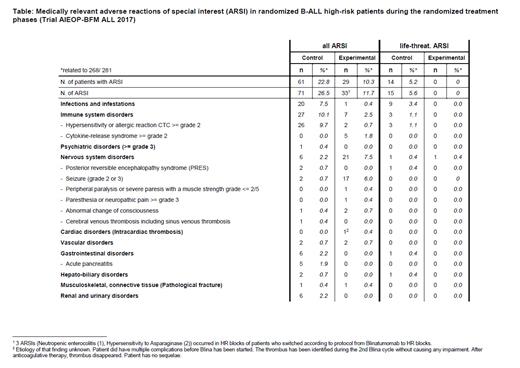Background: One of the key questions in trial AIEOP-BFM ALL 2017 focused on the reduction of treatment-related complications by replacing parts of the highly intensive consolidation phase by two courses of Blinatumomab (Blina) in a prospective randomized trial. Herein, we report the toxicity profile of B-cell acute lymphoblastic leukemia (B-ALL) patients (pts) with high-risk (HR) characteristics pending final outcome data.
Patients and Methods: 728 pts with HR B-ALL were enrolled from July 15, 2018 to October 31, 2022 in this multicenter trial run in 8 different countries. Patients were included in the HR group in view of the presence of at least one of the following criteria: induction failure; high levels of minimal residual disease (MRD) at day 15 of induction, or at the end of induction (EOI), or at the end of consolidation (EOC); presence of KMT2A::AFF1, of IKZF1+ and positive MRD at EOI (Stanulla et al, JCO 2018), TCF3::HLF, or hypodiploidy. B-ALL pts with one or several of these characteristics represented 20.8% of all pts aged 0-18 years of age with B-ALL.
After a 4-drug induction phase, and two weeks of consolidation treatment, patients were randomized to receive Bortezomib in addition to standard consolidation (not part of this report). Before treatment continued with intensive consolidation block HR-1', MRD was analyzed in order to identify patients eligible for subsequent hematopoietic stem cell transplantation (HSCT) based on MRD results. After block HR-1', all B-ALL HR pts were randomized to receive either two courses of consolidation (blocks HR-2', and HR-3'), or two 28-day courses of Blina at 15µg/m 2/d administered by continuous IV infusion (with a 2-week treatment-free interval). Two intrathecal injections of methotrexate (MTX) for CNS prophylaxis were given on days 1 and 29 of each Blina course, respectively. Out of 728 HR B-ALL pts, 619 pts were eligible for randomization [reasons for non-eligibility were: Event (death or relapse) before randomization was due (26), Down syndrome (25; scheduled for a non-randomized intervention with Blina), presence of TCF3::HLF (3; could receive any alternative therapy including Blina), discontinuation/substantial change of preceding therapy (23) or other protocol exclusion criteria (32)]. 572 pts were randomized (92.4% of those eligible). One pt assigned to the experimental arm (EA) and 4 pts assigned to the control arm (CA) received the other arms, respectively.
Results: Toxicity was evaluated in randomized pts according to treatment administered during the randomized phase, respectively, until next element started: 268 pts were treated in the control and 281 in the EA (see Table). 16 of them switched in/after the first Blina cycle to the HR blocks due to toxicity or poor response to Blina (due to increasing MRD, >=1x10 -4). Medically relevant adverse reactions of special interest (ARSI) according to MedDRA (specified in the protocol) were evaluated in the randomized treatment phases (CA: HR-2‘/HR-3‘ block, EA: 2 Blina cycles). ARSI were recorded in 61 of 268 pts in the CA (22.8%, 71 ARSI) and in 29 of 281 pts in the EA (10.3% [p<0.001], 33 ARSI); 3 of the 33 ARSI in the EA were related to HR blocks and were observed in 3 of the 16 pts that switched to HR blocks. Life-threatening SAR were seen in 14 pts of the control group (5.2%) and in no patient in the EA (p<0.001).
Conclusions: Taken together, these results show for the first time in newly diagnosed pts with HR B ALL, the favorable toxicity profile previously reported with Blinatumomab in pediatric relapsed ALL (Locatelli F et al, JAMA 2021; Brown P et al, JAMA 2021). We have demonstrated that the toxicity profile of Blinatumomab is much more favorable as compared to the intensive chemotherapy approach using HR-blocks. If upcoming analyses of outcome data will show no inferiority of the EA, blinatumomab replacement of some of the intensive chemotherapy blocks will become the new standard of care for treatment if newly diagnosed patients with HR B-ALL.
OffLabel Disclosure:
Locatelli:Miltenyi, Jazz Pharm, Medac, Sobi, Gilead, BluebirdBio: Speakers Bureau; Sanofi, Vertex: Membership on an entity's Board of Directors or advisory committees; Bellicum, Amgen, Neovii, Novartis. Sanofi, SOBI, Vertex: Membership on an entity's Board of Directors or advisory committees, Speakers Bureau. Cario:Servier, Amgen: Research Funding; JazzPharma: Speakers Bureau. Attarbaschi:JazzPharma: Honoraria. Elitzur:Jazz Pharmaceuticals: Honoraria; Medison Pharma: Honoraria. Rizzari:CLINIGEN, JAZZ, SERVIER, SERB: Consultancy, Honoraria, Speakers Bureau. Biondi:BMS: Membership on an entity's Board of Directors or advisory committees; Novartis: Speakers Bureau; Colmmune: Membership on an entity's Board of Directors or advisory committees, Research Funding; Galapagos: Membership on an entity's Board of Directors or advisory committees; Agmen: Speakers Bureau.
Blinatumomab is part of the randomized evaluation


This feature is available to Subscribers Only
Sign In or Create an Account Close Modal